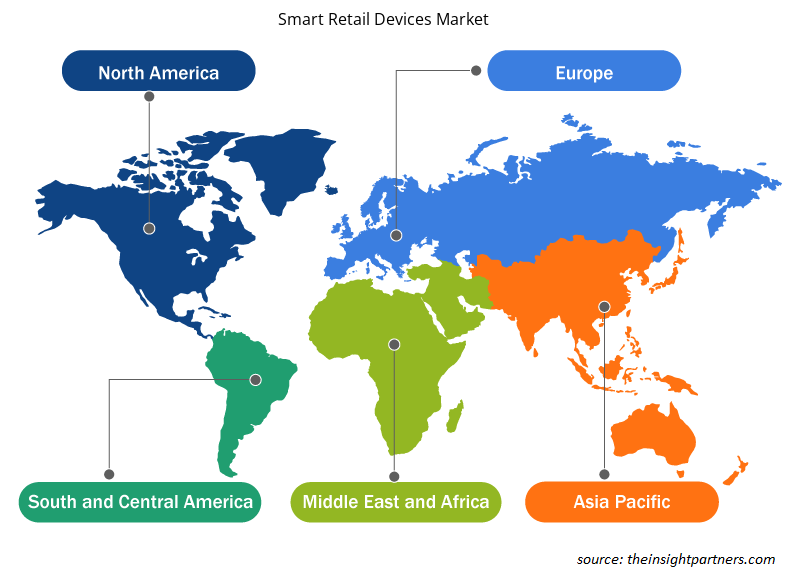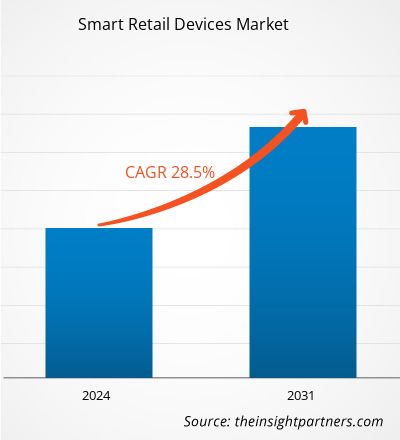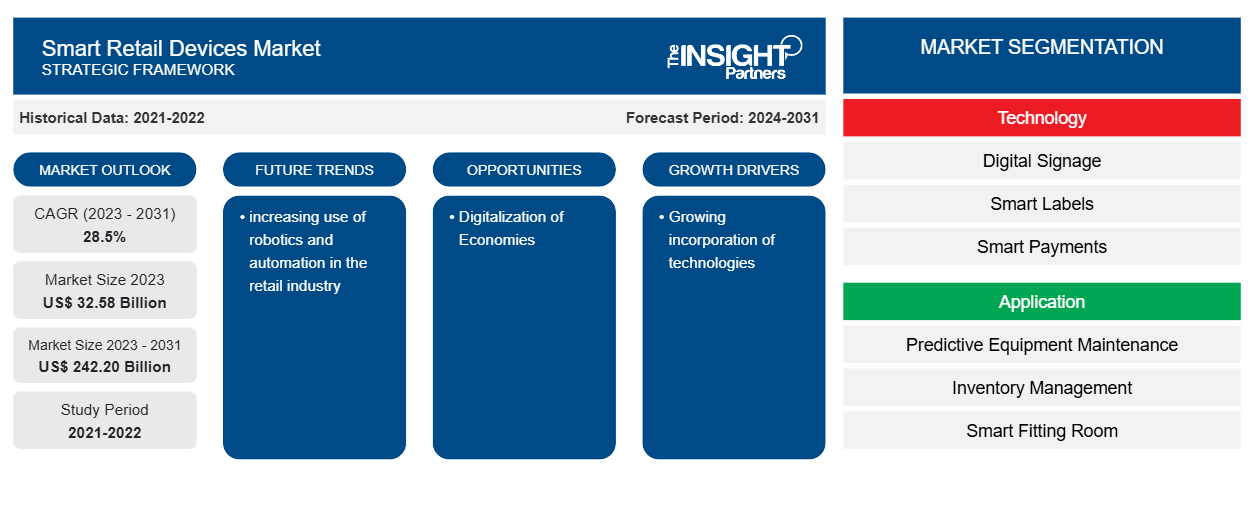Se espera que el tamaño del mercado de dispositivos minoristas inteligentes crezca de US$ 32,58 mil millones en 2023 a US$ 242,20 mil millones en 2031; se anticipa que se expandirá a una CAGR del 28,5% entre 2024 y 2031. Es probable que el uso creciente de la robótica y la automatización en la industria minorista siga siendo una tendencia clave del mercado de dispositivos minoristas inteligentes.CAGR of 28.5% from 2024 to 2031. The increasing use of robotics and automation in the retail industry is likely to remain a key smart retail devices market trends.
Análisis del mercado de dispositivos inteligentes para comercio minorista
La creciente adopción de análisis de big data e Internet de las cosas (IoT) en la industria minorista, junto con el aumento del poder adquisitivo de los consumidores, son los principales factores impulsores del mercado de dispositivos minoristas inteligentes.
Descripción general del mercado de dispositivos inteligentes para comercio minorista
El comercio minorista inteligente es el uso de tecnología y datos para mejorar las experiencias de compra de los clientes y las operaciones de las empresas. Estas tecnologías permiten a las organizaciones mejorar la experiencia del cliente, agilizar los procedimientos y obtener información importante sobre el comportamiento del consumidor. Estos dispositivos conectados a Internet permiten a los usuarios acceder fácilmente a información y servicios personalizados, mientras que las capacidades sofisticadas como el reconocimiento de voz y la integración del panel táctil hacen que las compras sean muy sencillas, con asistentes virtuales que guían a los consumidores para seleccionar los productos adecuados , examinar ofertas interesantes, realizar compras e incluso capturar y compartir experiencias en las redes sociales.
Personalice este informe según sus necesidades
Obtendrá personalización en cualquier informe, sin cargo, incluidas partes de este informe o análisis a nivel de país, paquete de datos de Excel, así como también grandes ofertas y descuentos para empresas emergentes y universidades.
-
Obtenga las principales tendencias clave del mercado de este informe.Esta muestra GRATUITA incluirá análisis de datos, desde tendencias del mercado hasta estimaciones y pronósticos.
Impulsores y oportunidades del mercado de dispositivos minoristas inteligentes
Creciente incorporación de tecnologías a favor del Mercado
La integración de tecnologías como la inteligencia artificial (IA), la realidad virtual (RV), la realidad aumentada (RA) y la Internet de las cosas (IdC) se utiliza cada vez más en la industria minorista para mejorar la experiencia de compra, mejorar la gestión de inventarios y agilizar las operaciones de las tiendas. La Internet de las cosas (IdC) es un componente importante en el entorno minorista inteligente porque vincula los dispositivos a Internet y ofrece datos vitales sobre el comportamiento de los clientes, las operaciones de la tienda y la gestión de inventarios. Los dispositivos de la IdC, como los sensores y las balizas, permiten a los comerciantes recopilar datos en tiempo real sobre los niveles de inventario, el flujo de clientes y los activos de la tienda, lo que les permite tomar decisiones más informadas y optimizar las operaciones.
Digitalización de las economías
El uso de la digitalización ofrece varios beneficios a las tiendas, incluida la adquisición de nuevos consumidores y la reducción de los costos operativos. Además, la digitalización tiene la capacidad de incentivar significativamente al personal minorista. Como resultado, los minoristas pueden ver un aumento en sus ingresos. Cabe destacar que las compras fuera de las tiendas experimentaron un crecimiento significativo en el año 2020. Es probable que los puntos de venta minoristas en línea se beneficien enormemente de las mejoras tecnológicas, el aumento de la conexión, la introducción de nuevos sensores y la disponibilidad de soluciones de comunicación fluidas , lo que contribuirá significativamente al crecimiento del mercado durante el período de pronóstico.digitalization provides several benefits to shops, including the acquisition of new consumers and the reduction of operational costs. Additionally, digitization has the ability to significantly encourage retail staff. As a result, retailers may see an increase in their revenues. Notably, non-store shopping witnessed significant growth in the year 2020. Online retail outlets are likely to benefit tremendously from technological improvements, increased connection, the introduction of novel sensors, and the availability of seamless
Análisis de segmentación del informe de mercado de dispositivos minoristas inteligentes
Los segmentos clave que contribuyeron a la derivación del análisis del mercado de dispositivos minoristas inteligentes son la tecnología y la aplicación.
- Según la tecnología, el mercado se divide en señalización digital, etiquetas inteligentes, pagos inteligentes, carritos inteligentes y otros. El segmento de señalización digital tuvo una mayor participación de mercado en 2023.
- En términos de aplicación, el mercado se divide en mantenimiento predictivo de equipos, gestión de inventarios, probadores inteligentes, monitoreo del tráfico peatonal y otros. El segmento de gestión de inventarios tuvo una mayor participación de mercado en 2023.
Análisis de la cuota de mercado de dispositivos inteligentes para comercio minorista por geografía
El alcance geográfico del informe de mercado de dispositivos minoristas inteligentes se divide principalmente en cinco regiones: América del Norte, Asia Pacífico, Europa, Oriente Medio y África, y América del Sur/América del Sur y Central. América del Norte dominó el mercado de dispositivos minoristas inteligentes en 2023. Se espera que esta región sea el principal generador de ingresos en el mercado durante todo el período de tiempo proyectado. El creciente deseo de productos de alta gama y artículos de lujo, junto con los cambios dinámicos en las preferencias de los clientes hacia experiencias minoristas más convenientes y eficientes en el tiempo, son factores importantes que impulsan esta tendencia. Además, la integración generalizada de la tecnología digital en varios sectores está remodelando la economía estadounidense. Las secuelas de la pandemia han acelerado significativamente la transformación digital de las empresas dentro de la industria minorista, superando las expectativas anteriores.
Perspectivas regionales del mercado de dispositivos minoristas inteligentes
Los analistas de Insight Partners explicaron en detalle las tendencias y los factores regionales que influyen en el mercado de dispositivos inteligentes para el comercio minorista durante el período de pronóstico. Esta sección también analiza los segmentos y la geografía del mercado de dispositivos inteligentes para el comercio minorista en América del Norte, Europa, Asia Pacífico, Oriente Medio y África, y América del Sur y Central.

- Obtenga datos regionales específicos para el mercado de dispositivos minoristas inteligentes
Alcance del informe sobre el mercado de dispositivos inteligentes para minoristas
| Atributo del informe | Detalles |
|---|---|
| Tamaño del mercado en 2023 | US$ 32,58 mil millones |
| Tamaño del mercado en 2031 | US$ 242,20 mil millones |
| CAGR global (2023 - 2031) | 28,5% |
| Datos históricos | 2021-2022 |
| Período de pronóstico | 2024-2031 |
| Segmentos cubiertos |
Por tecnología
|
| Regions and Countries Covered |
North America
|
| Market leaders and key company profiles |
|
Market Players Density: Understanding Its Impact on Business Dynamics
The Smart Retail Devices Market market is growing rapidly, driven by increasing end-user demand due to factors such as evolving consumer preferences, technological advancements, and greater awareness of the product's benefits. As demand rises, businesses are expanding their offerings, innovating to meet consumer needs, and capitalizing on emerging trends, which further fuels market growth.
Market players density refers to the distribution of firms or companies operating within a particular market or industry. It indicates how many competitors (market players) are present in a given market space relative to its size or total market value.
Major Companies operating in the Smart Retail Devices Market are:
- Intel Corporation
- Samsung Group
- NVIDIA CORPORATION
- LG Electronics
- Zebra Technologies Corporation
- Caper Inc.
Disclaimer: The companies listed above are not ranked in any particular order.

- Get the Smart Retail Devices Market top key players overview
Smart Retail Devices Market News and Recent Developments
The smart retail devices market is evaluated by gathering qualitative and quantitative data post primary and secondary research, which includes important corporate publications, association data, and databases. The following is a list of developments in the market:
- In June 2023, Intel and Vericast joined forces to develop, implement, and evaluate a cutting-edge programmable digital in-store retail media network. This innovative system leverages Vericast's advanced targeting technology and Intel's powerful Edge software platforms to deliver personalized advertising and product details that align with the customer's shopping journey. This collaboration is a crucial component of our broader initiative to revolutionize the retail industry and capitalize on the digital transformation of physical stores, which is widely regarded as the next major trend in the advertising sector.
(Source: Intel, Press Release, 2023)
- En noviembre de 2023, Panasonic Connect Europe presentó una nueva solución impulsada por IA que tiene como objetivo transformar la industria minorista al personalizar la publicidad a través de asistentes de IA generativos para los clientes mientras compran. Esta solución innovadora permite a las tiendas monitorear automáticamente la demografía de los compradores y combinar esta información con las preferencias de compra, los datos meteorológicos y los eventos locales para personalizar instantáneamente la publicidad en las pantallas de las tiendas. Panasonic se ha asociado con ADEAL Systems, un especialista líder en datos e IA, para integrar su asistente de compras personal impulsado por IA, CUSAAS (Customer Segmentation As-A-Service), con soluciones de cámaras y pantallas de tecnología minorista de última generación, creando una experiencia de compra mejorada.
(Fuente: Panasonic, Nota de prensa, 2023)
Informe sobre el mercado de dispositivos inteligentes para minoristas: cobertura y resultados
El informe "Tamaño y pronóstico del mercado de dispositivos minoristas inteligentes (2021-2031)" proporciona un análisis detallado del mercado que cubre las siguientes áreas:
- Tamaño del mercado y pronóstico a nivel global, regional y nacional para todos los segmentos clave del mercado cubiertos bajo el alcance
- Dinámica del mercado, como impulsores, restricciones y oportunidades clave
- Principales tendencias futuras
- Análisis detallado de las cinco fuerzas de Porter y PEST y FODA
- Análisis del mercado global y regional que cubre las tendencias clave del mercado, los principales actores, las regulaciones y los desarrollos recientes del mercado.
- Análisis del panorama de la industria y de la competencia que abarca la concentración del mercado, el análisis de mapas de calor, los actores destacados y los desarrollos recientes
- Perfiles detallados de empresas
- Análisis histórico (2 años), año base, pronóstico (7 años) con CAGR
- Análisis PEST y FODA
- Tamaño del mercado, valor/volumen: global, regional y nacional
- Industria y panorama competitivo
- Conjunto de datos de Excel
Informes recientes
Testimonios
Razón para comprar
- Toma de decisiones informada
- Comprensión de la dinámica del mercado
- Análisis competitivo
- Información sobre clientes
- Pronósticos del mercado
- Mitigación de riesgos
- Planificación estratégica
- Justificación de la inversión
- Identificación de mercados emergentes
- Mejora de las estrategias de marketing
- Impulso de la eficiencia operativa
- Alineación con las tendencias regulatorias























 Obtenga una muestra gratuita para - Mercado de dispositivos minoristas inteligentes
Obtenga una muestra gratuita para - Mercado de dispositivos minoristas inteligentes